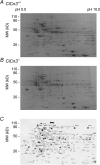Phenomics of cardiac chloride channels: the systematic study of chloride channel function in the heart
- PMID: 19171656
- PMCID: PMC2697290
- DOI: 10.1113/jphysiol.2008.165860
Phenomics of cardiac chloride channels: the systematic study of chloride channel function in the heart
Abstract
Recent studies have identified several chloride (Cl-) channel genes in the heart, including CFTR, ClC-2, ClC-3, CLCA, Bestrophin, and TMEM16A. Gene targeting and transgenic techniques have been used to delineate the functional role of cardiac Cl- channels in the context of health and disease. It has been shown that Cl- channels may contribute to cardiac arrhythmogenesis, myocardial hypertrophy and heart failure, and cardioprotection against ischaemia-reperfusion. The study of physiological or pathophysiological phenotypes of cardiac Cl- channels, however, may be complicated by the compensatory changes in the animals in response to the targeted genetic manipulation. Alternatively, tissue-specific conditional or inducible knockout or knockin animal models may be more valuable in the phenotypic studies of specific Cl- channels by limiting the effect of compensation on the phenotype. The integrated function of Cl- channels may involve multi-protein complexes of the Cl- channel subproteome and similar phenotypes can be attained from alternative protein pathways within cellular networks, which are influenced by genetic and environmental factors. Therefore, the phenomics approach, which characterizes phenotypes as a whole phenome and systematically studies the molecular changes that give rise to particular phenotypes achieved by modifying the genotype (such as gene knockouts or knockins) under the scope of genome/proteome/phenome, may provide a more complete understanding of the integrated function of each cardiac Cl- channel in the context of health and disease.
Figures






Similar articles
-
Phenomics of cardiac chloride channels.Compr Physiol. 2013 Apr;3(2):667-92. doi: 10.1002/cphy.c110014. Compr Physiol. 2013. PMID: 23720326 Free PMC article. Review.
-
Functional role of anion channels in cardiac diseases.Acta Pharmacol Sin. 2005 Mar;26(3):265-78. doi: 10.1111/j.1745-7254.2005.00061.x. Acta Pharmacol Sin. 2005. PMID: 15715921 Review.
-
Expression and function of CLC and cystic fibrosis transmembrane conductance regulator chloride channels in renal epithelial tubule cells: pathophysiological implications.Chang Gung Med J. 2007 Jan-Feb;30(1):17-25. Chang Gung Med J. 2007. PMID: 17477025 Review.
-
Chloride channels in the kidney: lessons learned from knockout animals.Am J Physiol Renal Physiol. 2002 Dec;283(6):F1176-91. doi: 10.1152/ajprenal.00184.2002. Am J Physiol Renal Physiol. 2002. PMID: 12426234 Review.
-
Molecular physiology of CFTR Cl- channels in heart.Jpn J Physiol. 1994;44 Suppl 2:S177-82. Jpn J Physiol. 1994. PMID: 7752524
Cited by
-
SCN4A variants and Brugada syndrome: phenotypic and genotypic overlap between cardiac and skeletal muscle sodium channelopathies.Eur J Hum Genet. 2016 Mar;24(3):400-7. doi: 10.1038/ejhg.2015.125. Epub 2015 Jun 3. Eur J Hum Genet. 2016. PMID: 26036855 Free PMC article.
-
Unravelling the complexity of Cl- channels: how long is a piece of string?J Physiol. 2009 May 15;587(Pt 10):2113-4. doi: 10.1113/jphysiol.2009.172825. J Physiol. 2009. PMID: 19443850 Free PMC article. No abstract available.
-
Role of ion channels in heart failure and channelopathies.Biophys Rev. 2018 Aug;10(4):1097-1106. doi: 10.1007/s12551-018-0442-3. Epub 2018 Jul 17. Biophys Rev. 2018. PMID: 30019205 Free PMC article. Review.
-
Transient complex I inhibition at the onset of reperfusion by extracellular acidification decreases cardiac injury.Am J Physiol Cell Physiol. 2014 Jun 15;306(12):C1142-53. doi: 10.1152/ajpcell.00241.2013. Epub 2014 Apr 2. Am J Physiol Cell Physiol. 2014. PMID: 24696146 Free PMC article.
-
CFTR prevents neuronal apoptosis following cerebral ischemia reperfusion via regulating mitochondrial oxidative stress.J Mol Med (Berl). 2018 Jul;96(7):611-620. doi: 10.1007/s00109-018-1649-2. Epub 2018 May 14. J Mol Med (Berl). 2018. PMID: 29761302
References
-
- Bahinski A, Nairn AC, Greengard P, Gadsby DC. Chloride conductance regulated by cyclic AMP-dependent protein kinase in cardiac myocytes. Nature. 1989;340:718–721. - PubMed
-
- Baker MA, Lane DJ, Ly JD, De Pinto V, Lawen A. VDAC1 is a transplasma membrane NADH-ferricyanide reductase. J Biol Chem. 2004;279:4811–4819. - PubMed
-
- Batthish M, Diaz RJ, Zeng HP, Backx PH, Wilson GJ. Pharmacological preconditioning in rabbit myocardium is blocked by chloride channel inhibition. Cardiovasc Res. 2002;55:660–671. - PubMed
-
- Baumgarten CM, Clemo HF. Swelling-activated chloride channels in cardiac physiology and pathophysiology. Prog Biophys Mol Biol. 2003;82:25–42. - PubMed
-
- Baumgarten CM, Fozzard HA. Intracellular chloride activity in mammalian ventricular muscle. Am J Physiol Cell Physiol. 1981;241:C121–C129. - PubMed
Publication types
MeSH terms
Substances
Grants and funding
LinkOut - more resources
Full Text Sources

